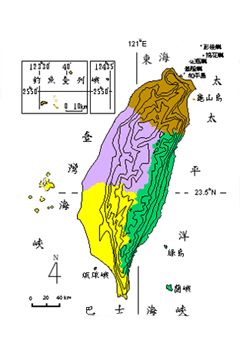The Hazards of Taiwan

Relevant Websites
- National Science and Technology Program for Hazards and Mitigation Office
- Tai-feng-zai-hai-lei-xing
- Central Geological Survey
- 921 Chi-Chi Earthquake
- 921 Di-zhen-zai-hai-di-li-zi-xun-cha-xun
- Shui-tu-bao-chi-tu-shi-liu-zhuan-ji
- Guo-jia-di-zhen-fang-zhen-zhong-xin
- Geologic Hazard(USGS)
- The Chi-Chi Earthquake in Taiwan
- Major Earthquake in Taiwan
- Mud-Rock Slide
Reference
- Environmental Protection Administration Government of R.O.C. edited, 1995: Zhong-hua-min-guo-tai-wan-di-qu-huan-jing-zi-xun, Taipei, Environmental Protection Administration Government of R.O.C, pp. 25-30.
- Chen, Kuo-yen, 1982: Tai-wan-long-juan-feng-zhi-pin-lu-yu-feng-bu, Di-li-xue-yan-jiu, Vol. 6, pp. 55-68.
- Chen, Kuo-yen, 1986: Tai-wan-de-shui-zai-lei-xing-yu-feng-bu, Zhong-guo-di-li-xue-hui-kan, pp. 27-38.
- Chen, Kuo-yen, 1986: Qin-tai-zhi-tai-feng-lu-jing-yu-qiang-du, Shi-da-di-li-yan-jiu-bao-gao, Vol. 7, pp.61-74.
- Chen, Kuo-yen, 1983: Dong-ya-zhi-mei-yu, Di-li-xue-yan-jiu, Vol. 7, pp. 35-48.
Taiwan's natural and human hazards include weather, earthquakes, sudden slumps, land subsidence, improper use of land and careless management of construction projects.
A. Weather Hazards
Situated in a subtropical monsoon climate, Taiwan is visited every year by irregular plum rains from May to June and rainstorms from July to September. They often result in serious damage. According to the Central Weather Bureau, between 1897 and 1990 Taiwan was hit by more than 340 typhoons, an average of 3.6 a year. Besides the hazards caused by wind and floods, such weather conditions as drought, cold waves, hail and tornados also lead to severe loss of life and money. Losses of over NT$14.2 billion were recorded from 1961 to 1991, almost 0.68% of Taiwan's GNP.
B. Earthquake Hazards
Located on the edges of the Eurasian and Philippine plates, Taiwan is one of the most earthquake-prone places in the world. Over 50 destructive earthquakes were recorded before 1900 and as many as 83 after 1900. These devastating quakes, which occur on an average of almost once a year, have claimed more than five thousand lives so far. On September 21, 2000, the Chi-chi earthquake, with a magnitude 7.3, took more than two thousand lives overnight.
C. Slump Hazards
Because of its complex geological structures and slightly unstable crust, Taiwan experiences frequent slumps-landslides and cave-ins. Earthquakes and heavy rains brought by typhoons contribute to these events. Taipei and Keelung, with their over-developed hills, suffer the greatest number of slumps. Most of these occur in the form of landslides, some in the form of debris flows.
D. Land Subsidence Hazards
The fish-farming industry in western and northeastern Taiwan requires several times more ground water than is needed for irrigation. This kind of over-pumping of ground water results in serious land subsidence or sinking in the coastal areas. According to a recent survey, an area of up to 1,097 square kilometers suffers from subsidence: this is 3% of the island's total land area and 9% of its flat area. This problem obviously needs an immediate and effective solution.
E. Urban-Related Hazards: Improper Use of Land
As Taiwan is mountainous, its limited plains and hills are over-crowded with people and cities. Even uninhabitable hillsides and lowlands near the cities are exploited. This improper use of land makes Taiwan more vulnerable to natural disasters.
In order to improve the quality of life and balance regional development in Taiwan, many large-scale public facilities are being built or have recently been completed. These include highways, high-speed railways, nuclear power plants, science parks, coastal industrial parks, flood control works and sewage systems. However, these construction projects put great pressure on the land, stretching its capacity to the limit. These facilities need to be well maintained and their safety guaranteed; they need to be able to withstand such natural hazards as floods, high winds and earthquakes. To maintain the highest standards in construction and maintenance is a challenge Taiwan faces.
The Characteristics of Natural Hazards
Many factors contribute to the occurrence of natural hazards. Their characteristics can be summed up as follows: A. Space;B. Time;C. Domino effect;D. Accumulation;E. Complexity and F. Compound nature.